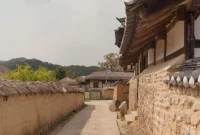Explore the rich cultural heritage of Korea through a journey to its traditional villages. Immerse yourself in the charm of ancient architecture, traditional customs, and the serene beauty of these villages. Join us as we take a glimpse into the captivating past of Korea’s traditional way of life.
The Preservation of Traditional Korean Villages
Traditional Villages of Korea: A Glimpse into the Past is an exploration of the rich cultural heritage found within the traditional Korean villages. These villages, scattered throughout the country, offer visitors a unique opportunity to experience the customs and traditions of ancient Korea.
The preservation of these villages is crucial for maintaining the cultural identity of Korea. These architectural gems provide a window into the past, showcasing the traditional homes, temples, and communal spaces of the Korean people. The intricate detailing, craftsmanship, and use of natural materials in these historical structures speak volumes about the skills and creativity of the ancestors.
Efforts have been made to protect and restore these traditional villages. Various government organizations, non-profit groups, and local communities have collaborated to ensure their preservation. Strict regulations and guidelines are implemented to safeguard the authenticity and integrity of these sites. This includes preserving the original architecture, limiting commercialization, and promoting sustainable tourism practices.
Visiting these traditional villages offers a chance to immerse oneself in the ancient way of life. Walking through the narrow cobblestone pathways, observing traditional ceremonies, and engaging with locals provides a glimpse into the customs and traditions that have shaped Korea’s history. The tranquility and serenity of these villages offer a respite from the fast-paced modern world, allowing visitors to connect with nature and experience a deep sense of cultural appreciation.
In conclusion, the preservation of traditional Korean villages is essential for understanding and appreciating the rich cultural heritage of Korea. These villages serve as living museums, allowing visitors to travel back in time and witness the beauty and simplicity of traditional Korean life. By protecting and promoting these sites, we are not only preserving the past but also ensuring that future generations can continue to learn from and be inspired by the traditions of old.
Traditional Houses and Their Features
In the traditional villages of Korea, you can experience a glimpse into the past through their unique traditional houses. These houses, known as hanok, are deeply rooted in Korean culture and hold historical significance. One of the distinct features of hanok is their architectural design.
Hanok houses are typically made of natural materials such as wood, stone, and clay. The roofs are curved and covered with traditional Korean tiles called giwa. The walls are usually decorated with intricate paintings, showcasing the artistic talents of the past. The houses are designed to harmonize with nature, often featuring inner courtyards and gardens.
Another notable feature of hanok is the ondol system. This unique heating system involves an underfloor heating system, which uses a network of pipes to circulate warm air. Ondol not only provides warmth during the cold Korean winters but also plays a significant role in promoting good health.
Additionally, hanok houses are designed to be eco-friendly and sustainable. The strategic positioning of windows and doors allows for natural ventilation and daylight. The hanok structure is also flexible, allowing for easy reconstruction and expansion.
Traditional villages in Korea, such as Bukchon Hanok Village in Seoul or Yangdong Folk Village in Gyeongju, offer visitors the opportunity to step into the past and appreciate the beauty of hanok houses. These traditional houses are not only a reflection of Korean heritage but also a testament to the wisdom and ingenuity of their architects.
Traditional Crafts and Cultural Heritage
The traditional villages of Korea offer a captivating glimpse into the past, showcasing the rich cultural heritage of the country. These villages are not only picturesque and charming, but they also serve as living museums that preserve the traditional crafts and customs of generations gone by.
One can find a wide range of traditional crafts in these villages, each telling a unique story. From pottery and ceramics to hanbok (traditional clothing) making, visitors can witness skilled artisans practicing their craft with utmost precision and dedication. These crafts are not merely decorative, but they also hold deep cultural significance, reflecting the identity and values of the Korean people.
Exploring these traditional villages provides a window into the past, where one can immerse themselves in the traditions and customs that have shaped the Korean culture. The villages are often designed in a way that reflects the harmony between nature and human habitation, with houses built using natural materials and blending seamlessly with the surrounding landscapes.
Additionally, traditional performances and rituals are often held in these villages, allowing visitors to witness firsthand the vibrant cultural practices of Korea. From traditional dance performances to music concerts, these events present an opportunity to experience the living heritage of the country.
Visiting the traditional villages of Korea is not just a chance to admire the beauty of the past, but also an opportunity to support the preservation of these cultural treasures. By showcasing the traditional crafts and customs, these villages play a crucial role in safeguarding and passing on the intangible cultural heritage to future generations.
Conclusion
The traditional villages of Korea offer a mesmerizing glimpse into the nation’s rich cultural heritage and historical past. With their well-preserved traditional architecture, vibrant local traditions, and warm hospitality, these villages provide visitors with an immersive experience that takes them back in time. Exploring these hidden gems allows travelers to appreciate the authenticity of Korean culture and enjoy a break from the fast-paced modern world.




